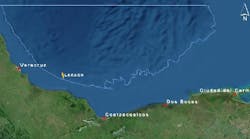Saga pursuing new exploration concepts that have value in shallow
water and development drilling
Nick Terdre
Correspondent - Europe
- A smaller than usual derrick and a lightweight drilling machine provide space and weight economies on the EfEx rig.
- The day-rate cost of an EfEx rig should be well below that of conventional units over a range of water depths.
Norway's 15th licensing round is expected to open up virgin deepwater areas in the Voering Basin, a prospect which has excited explorationists who believe that the region may contain large hydrocarbon reserves.
But drilling costs using a fourth generation dynamically positioned (DP) rig could be prohibitively high, ranging from Nkr200 million to Nkr450 million per well, according to Tor Stein Olberg, chief engineer of Saga Petroleum's drilling and well technology operations division.
"There is a chance that we could see ten wells, and then, if the results were poor, exploration might stop," says Olberg. 'That would be a pity as the mid-Norway region is as big as the Norwegian North Sea."
With Norway's industry cost reduction program (Norsok) principles firmly in mind, Saga has come up with a novel concept to drastically reduce deepwater drilling costs - using second generation rigs to drill slender wells. Encouraging results were obtained in a concept feasibility study carried out last year in which suppliers Unit Rig, ABB Vetco Gray, and Dolphin participated.
The idea, dubbed EfEx for efficient exploration, is particularly appropriate at a time when a tight market has pushed up day-rates for third and fourth generation units, while many second generation rigs are finding work difficult to come by.
Technical feasibility is taken as confirmed, though the commercial applicability of the concept has yet to be proven, Olberg says. But the commercial signs are promising.
There are four main functional requirements that must be satisfied in drilling exploration wells, Olberg says:
- The well must penetrate safety to prospective reservoir levels.
- It should provide formation data using available logging tools.
- It should be able to retrieve cores.
- It should hold out the possibility of testing.
The slender well design satisfies all these requirements. Working from the bottom up, a 5-1/2 in. hole with 4-1/2 in. liner is sufficient for perforation and testing. For a well penetrating some 4,500 meters beneath sea level, an 11-in. wellhead would be required.
Available logging tools could be used in the bottom hole section. Although it would not be possible to bring out conventional 4-in diameter cores, smaller cores could be retrieved. Olberg says that the Norwegian Petroleum Directorate (NPD), which has a claim on part of any cores retrieved, is willing to discuss accepting smaller samples.
From the slender well dimensions, other economies flow. An 80-ton BOP stack could be used, compared with a 220-240 ton stack for a conventional well. A 13-3/8 in. riser would be sufficient, Olberg says, and this would save a lot of space and weight on the rig deck.
A light, compact drilling machine would be used, requiring a derrick with a height only 60% of the conventional derrick. This would free an extra 500-ton of available deck load. Another advantage is that the risk to personnel would be reduced by having all the work done on one level.
Overall, the number of personnel onboard would be 40-50, as against the standard 60-80, thus generating additional savings.
The reduced well dimensions mean that the consumption of drilling fluid and the volume of drill cuttings would both be reduced by having a factor of three, while carbon dioxide emissions would be halved.
As for the mooring system, Olberg says that a combination of 2,000 meters of wire in the middle and chain at top and bottom would be preferable to an all-chain system. Such a combination is already used, for example, in Brazil.
The indications are that substantial cost savings are achievable. The day-rate for an EfEx rig drilling in a water depth of 1,000 meters would be of the order of $60,000, compared with around $110,000 for a fourth generation dp unit.
A well which would cost Nkr120 million to be drilled by a fourth generation rig would cost approximately Nkr70 million, close to half if drilled in accordance with the EfEx concept, Olberg says.
But a carefully tailored long-term contract will be required to make the Nkr250 million investment in modifications a practical proposition for a drilling contractor, he acknowledges.
Contractors have been briefed on the project, and prequalification applications containing their ideas on how to proceed with the modifications were due back in mid-March. Up to three bidders will then be chosen to continue with pre-engineering, and a contract for 15-20 wells over a three-year period will be awarded in mid-year, calling for a rig to be ready for operations in late 1996.
Verification of the concept will be paid for by Saga and Statoil, which have agreed to participate in the project. However, other operators will be invited to have wells drilled as part of the drilling contract.
There is even more potential to the EfEx concept, Olberg believe, it is also applicable to conventional water depths, as the slender well design satisfies the criteria for probably 50% of all exploration wells, and opens the way to a 25-30% reduction in costs at these depths.
It also fulfills the requirements for many development wells, thus offering cost savings for the deepwater development phase.
Copyright 1995 Offshore. All Rights Reserved.




